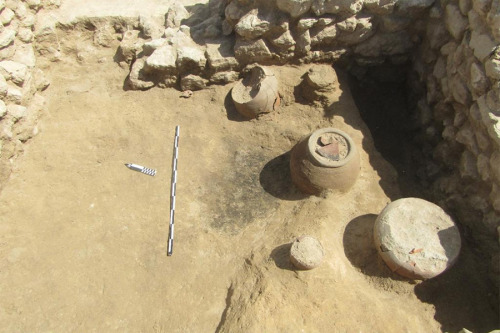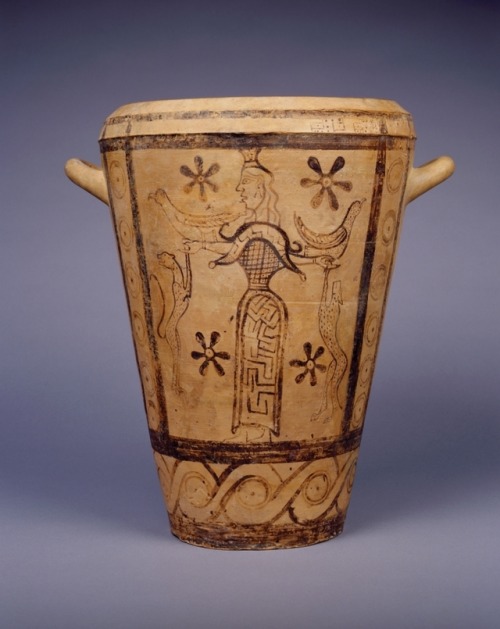#ancient greece

Tetradrachm of the polisof Rhegion (present-day Reggio Calabria) in Bruttium, south Italy. On the obverse, a lion’s head; on the reverse, the head of Apollo, crowned with laurel. Artist unknown; minted between 410 and 387 BCE. Photo credit: Classical Numismatic Group, Inc. http://www.cngcoins.com
Ancient Greek Pottery Workshop and Storage Facility Discovered in Alexandria
An Egyptian archaeological mission uncovered an Ancient Greek pottery workshop and a storage building at Tabet Al-Motaweh area to the west of Alexandria.
Mostafa Waziri, secretary-general of the Supreme Council of Antiquities, said a collection of kilns were discovered in the workshop, including two engraved in rocks, according to Ahram.
The first has a vaulted entrance through which workers passed to line up amphora in rows. The entrance is covered with clay and fragments.
Studies revealed the workshop was used throughout different periods. The northern side was used as a kiln for cement during the Byzantine time.
It was completely destroyed during the Middle Ages and converted into a cemetery. Inside one of the kilns a burial for a pregnant woman was uncovered.
Ayman Ashmawi, head of the Ancient Egyptian Antiquities Sector, said a storage was also unearthed containing a large collection of clay pots used for cooking.
The storage building comprised dorms for workers during the Ptolemaic era. It has 13 chambers, including one for religious rituals and prayers, another used as a kitchen, and a third for selling pots.
Inside the cooking pots bones of cattle and fish were found.
A large collection of Ptolemaic coins bearing the faces of Alexander the Great, deity Zeus and Queen Cleopatra were found on the floor of one of the chambers, while two large terracotta statues for deity Harpocrates and a yet unknown king in a very bad conservation condition were discovered in another chamber.
Hunting hooks and deity statues were found along with 100 catacombs.
Post link
Discos, around 500 BCE. Bronze. Found in Messina, Sicily. Via Kunsthistorisches Museum, Vienna
The image of the dolphin, symbolizing the trajectory of the discus, was obviously inserted in multicolored material. The edge is partly undercut, partly left rough to ensure better adhesion in the bedding. Undoubtedly, the discus was a consecration gift and not a sports device: In competition, the incrustation would certainly have fallen out upon repeated impact with the ground.
Post link
“Said to have been found by George Nugent Grenville, Lord High Commissioner of the Ionian Islands, in Greece in 1834, the Corinthian helmet that contained the skull of its wearer is believed to date from the Battle of Marathon. The battle between Greek and Persian forces in 490 BCE gives rise to the legend of Pheidippides, the Athenian messenger who ran throughout Greece to warn of the impending battle and father of the modern marathon”.
Post link
I saw that the author of the bad Ariadne book wrote a book about Elektra and my immediate reaction was like “ew no thanks” but then I was like “you should read it just to know how bad it is”
Hades: you can’t look back
Orpheus: I won’t
Orpheus:

Greek gods as B99 gifs part 2
Hera:

Zeus:

Poseidon:

Hestia:

Hades:

Bonus (I know some of these aren’t B99 quotes but still):
Iris:

Hypnos:

Or

The Orcale in Ancient Greece when it foretold a prophecy:




Acrópolis, Atenas

GIOVANNI BATTISTA TIEPOLO
ITALIAN, 1696–1770
THE CHARIOT OF AURORA
c. 1734
Oil on canvas
19 7/16 x 19 1/8 in. (49.3 x 48.6 cm)
The chariot of Aurora, goddess of the dawn, ascends into the sky to begin a new day. Sunflowers turn toward the light, while a bat flees with the darkness. A winged boy, or putto, awakens Aurora’s brother, the sun god Helios.
The broad brushstrokes and small scale of this canvas suggest that it was made as a sketch for a larger painting. Its subject matter would have been perfectly appropriate for the ceiling of a bedroom in an opulent eighteenth-century home.
From the Clark Institute Website.

Nymphs and Satyr
William-Adolphe Bouguereau, 1873, oil on canvas.
Inspired by a passage of Statius’ Silvae.
For forty years at the beginning of the 20th century, the painting was hidden away in storage because its buyer deemed it too provicative for public display.

THE WEDDING OF PELEUS AND THETIS
This month we’re going to take a look at Classical mythology and history and it’s reception in later art !!!
A scene super popular in Archiac Greek pottery, the subject of Joachim Anthonisz Wtewael’s painting The Wedding of Peleus and Thetis in 1612.
Check out the Clark art gallery for more info
Marble head of a Greek general
Roman, 1st–2nd century A.D., copy of a 4th C. Greek bronze.
NY Met. 24.97.32.
Post link
Jar with a Mistress of the Wild Animals
7th Century BCGreek, Cretan
http://carlos.digitalscholarship.emory.edu/items/show/8548
Post link


Doodles of other ancient greek figures- Circe and Hermes
Pylades: I’ll take care of you
Orestes: It’s rotten work
Pylades: Not to me. Not if it’s you.
look all i’m saying is that if i found a guy with a stable job, a nice house, and a big dog, i, too, would eat the pomegranate seeds
Cat
Its eyes being variable, the cat symbolizes the varying power of the sun and the waxing and waning of the moon and the splendour of the night; it also denotes stealth; desire; liberty.
As black it is lunar, evil and death; it is only in modern times that a black cat has been taken to signify good luck.
Amerindian: The wild cat portrays stealth.
Celtic: Chthonic powers; funerary.
Chinese: A yin animal as nocturnal; powers of evil; powers of transformation. A strange cat is unfavourable change; a black cat, misfortune, illness.
Christian: Satan; darkness; lust; laziness.
Egyptian: Lunar, sacred to Set as darkness; as lunar the cat can also be an attribute of Isis and of Bast, the moon; it represents pregnant women as the moon makes the seed grow in the womb.
Graeco-Roman: Attribute of the lunar Diana. The goddess of liberty has a cat at her feet.
Japanese: Powers of transformation; peaceful repose.
Scandanavian: Attribute of Freyja, whose chariot is drawn by cats.
Witchcraft: A familiar and disguise of witches; the black cat as the witches’ familiar is evil and ill luck. Cats and dogs as witches’ familiars are rain-makers.
[Source: An Illustrated Encyclopedia of Traditional Symbols by J.C. Cooper]
Post link
“I was driven thence by foul winds for a space of 9 days upon the sea, but on the tenth day we reached the land of the Lotus-eaters, who live on a food that comes from a kind of flower.
Here we landed to take in fresh water, and our crews got their mid-day meal on the shore near the ships.
When they had eaten and drunk I sent two of my company to see what manner of men the people of the place might be, and they had a third man under them.
They started at once, and went about among the Lotus-eaters, who did them no hurt, but gave them to eat of the lotus, which was so delicious that those who ate of it left off caring about home, and did not even want to go back and say what had happened to them, but were for staying and munching lotus with the Lotus-eaters without thinking further of their return; nevertheless, though they wept bitterly I forced them back to the ships and made them fast under the benches.
Then I told the rest to go on board at once, lest any of them should taste of the lotus and leave off wanting to get home, so they took their places and smote the grey sea with their oars.”
From the Odyssey
Post link



















